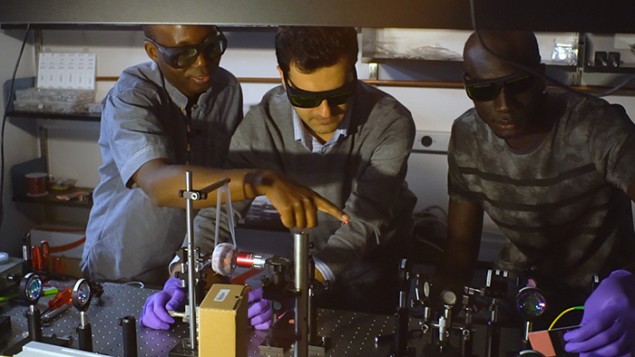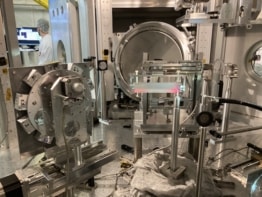
A new kind of laser, in which light snakes around a cavity of any shape without scattering, has been developed by researchers in the US. They claim that their “toplogical laser”, which works at telecom wavelengths, could allow improved miniaturization of silicon photonics or even protect quantum information from scattering.
Topological insulators are materials that do not carry electrical currents in the bulk, but do conduct through edge states. Crucially, these states always travel in one direction, steering neatly around corners and imperfections in the surface without scattering or leaking out.
Such “topologically protected” electric currents can be induced in a thin sheet of any conductor by inducing an electric field across the sheet and a magnetic field perpendicular to it. In the bulk, the electrons simply travel in circles but at the edges they hop along in semicircles.
Although photons have no magnetic moment and so do not respond directly to a magnetic field, an analogous effect can be achieved using electrons excited by incident light. Such electrons respond differently to a magnetic field than if they had not been excited, and in turn influence the light differently.
“The interaction of the photons with the magnetic field is mediated by the material,” explains Boubacar Kanté, an applied physicist at the University of California, San Diego. That’s the theory – and it works well at low frequencies.
From theory to experiment
However, at the infrared wavelengths used in silicon photonics, materials respond so weakly to magnetic fields that many researchers had assumed it would not be possible to open up an optical band gap – a spectral region in which the bulk of a material cannot transmit electromagnetic waves.
Undaunted, Kanté and some of his students “started doing some calculations to really check whether some of these assumptions were correct”. They realised that while it would be possible to block bulk transmission in only a tiny wavelength band, this drawback would be useful in a laser, which is meant to have a narrow linewidth.
To find out, the researchers used two photonic crystals – periodic optical nanostructures – made from indium gallium arsenide phosphide. They placed one inside the other on top of a layer of the magnetic mineral yttrium iron garnet. The inner photonic crystal consisted of a series of star-shaped unit cells arranged in a square lattice, whereas the outer crystals had a triangular lattice of cylindrical holes. The interface between the two crystals is the laser cavity, in which laser amplifcation can take place.
Creating a band gap
The different patterns of the two photonic crystals gave rise to a one-way, robust photonic edge state, much like the electronic edge states in a topological insulator. The magnetic field opened an optical band gap just 42 picometres wide in the bulk photonic crystals, making them both perfectly reflective at about 1550 nm – the wavelength region most often used for fibre-optic transmission.
“If I take two mirrors that are topologically distinct,” explains Kanté, “then, because they are mirrors, light cannot penetrate the crystals; but, because they are topologically distinct, light can propagate in between them”.
Indium gallium arsenide phosphide spontaneously emits light when excited by a laser, with this light populating the edge state that exists between the topologically distinct materials. This edge state can then be used to make a scattering-proof laser cavity of any shape.
Extracting the beam
To extract a beam, the researchers removed a line of holes from the outer photonic crystal, creating a waveguide coupled to the cavity’s evanescent field – a type of non-propagating electromagnetic disturbance that occurs as a result of the waves in the cavity. They found that the light emerged from the waveguide with a strong preference for one direction, proving the light had come from the one-way edge mode.
This feature could be useful, say the researchers, because a laser beam reflecting back into the cavity can inject noise and even destroy high-power cavities. Devices designed to prevent this are usually bulky and energy intensive. “Now we have a device that can send light in a preferential direction with no way for it to come back to the source,” says Kanté.
The researchers also suggest that cavities of any shape could allow denser packing of integrated optoelectronic components, and consequently higher processing speeds. Finally, they note the use of scattering-free photonic paths could transport quantum states longer distances around quantum circuits. The researchers are now making an electricallly powered laser because – as Kanté puts it – “you don’t want to carry one big laser to feed another one.”
Quite remarkable
“I think it’s the first topological photonic material that is non-reciprocal because of magnetic bias in optics,” says Andrea Alù of the University of Texas at Austin. “That’s quite a remarkable result and I know many people were trying to do it.” Alù is, however, more sceptical about some of the potential applications, such as the miniaturization of lasers. “To define a photonic crystal, you need many unit cells,” he says. “Typically, the first band gap arises when the distance within the unit cells is a half-wavelength – so 750 nanometres. And you need a lot of them to create that interface. There are ways to make much smaller lasers than this.” One potentially interesting aspect not mentioned in the research, he suggests, is the possibility of creating a laser beam with angular momentum.
The laser is unveiled in Science.


